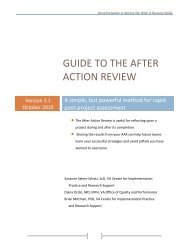The Veteran Supported Education Service Treatment Manual: VetSEd
The Veteran Supported Education Service Treatment Manual: VetSEd
The Veteran Supported Education Service Treatment Manual: VetSEd
Create successful ePaper yourself
Turn your PDF publications into a flip-book with our unique Google optimized e-Paper software.
B. Engaging Schools<br />
<strong>The</strong> <strong>VetSEd</strong> mobile model presumes that the peer <strong>VetSEd</strong> provider will be making<br />
contact with schools and training settings and that the majority of these contacts will be<br />
on the behalf of an individual <strong>Veteran</strong>. (In other models, you may have responsibility for<br />
building bridges between VA and the campus on a larger scale). This may involve, for<br />
example, helping connect the <strong>Veteran</strong> with a student <strong>Veteran</strong> center, promoting<br />
awareness among faculty about <strong>Veteran</strong> mental health issues, organizing <strong>Veteran</strong>s<br />
student events, or sponsoring visits from VA Medical Center to the campus or vice versa.<br />
<strong>The</strong> following section describes strategies that may be helpful as you approach a school<br />
system on behalf of a <strong>Veteran</strong>. Two main types of school contacts are highlighted:<br />
Contacts for Information and the School Development Interview.<br />
i. Contacts for Information<br />
When you have a <strong>Veteran</strong> who is specifically looking for more information about a<br />
school or training program, it is usually best to contact the school or training program.<br />
For this contact, you can go wherever it makes sense given the <strong>Veteran</strong>‘s questions. For<br />
example, if the <strong>Veteran</strong> has a question about financial aid, it would make sense to go<br />
directly to the financial aid office. If the <strong>Veteran</strong> has a question about specific courses or<br />
about a program of study, it would make sense to contact the head of that department.<br />
If the <strong>Veteran</strong> wants you to do this on his/her behalf, you will need the VA Release of<br />
Information (ROI). A sample ROI with instructions for the proper completion of an ROI<br />
is provided in Appendix F. Ask the <strong>Veteran</strong> or use the school‘s Web site to identify the<br />
most appropriate persons who may be able to answer your question. Some questions may<br />
be effectively answered over the phone or through an e-mail exchange (do not to use the<br />
<strong>Veteran</strong>‘s name or any identifying information in the e-mail; if you need to share this<br />
information in order to get the question answered, the business must be conducted over<br />
the phone or in person).<br />
You can introduce yourself as an <strong>Education</strong> Specialist from the Department of <strong>Veteran</strong>s<br />
Affairs. You may also decide to include that you are a peer and fellow <strong>Veteran</strong> who<br />
assists other <strong>Veteran</strong>s in a number of ways, mainly transitioning from military to civilian<br />
life, including entering school and using their GI Bill benefits. That is usually enough<br />
information for most folks to begin helping you.<br />
If you are speaking on behalf of the <strong>Veteran</strong>, it may be helpful to bring the VA ROI with<br />
you, but understand that they may also require the student to sign the school‘s own ROI<br />
to talk with you. In some cases, you will definitely need to pursue this path. But, it is also<br />
74 | P a g e
















